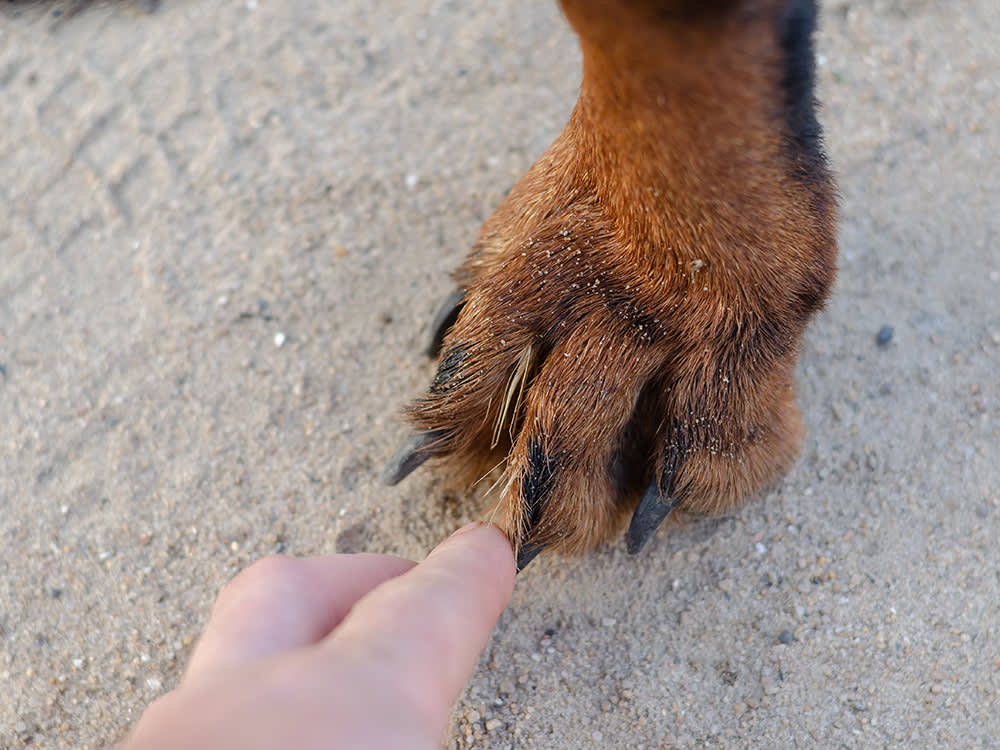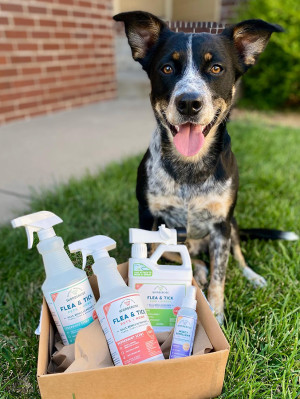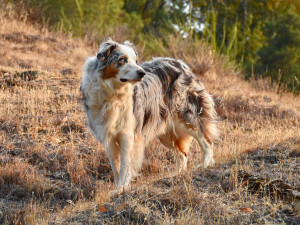Why Foxtails Are So Dangerous for Your Dog
Late spring is prime time for these blades of grass that pose a serious risk to your pup.
As an ER vet, I officially mark the start of spring when I see several dogs over the course of a 10-hour shift with the same presenting complaint: sudden sneezing. And I’m not talking seasonal allergiesopens in new tab. Enter, a new enemy you might not be aware of: foxtails.
The pesky seeds from these dried grasses get stuck everywhere, and I mean everywhere — especially in a pup’s fur. Many pet parents have heard the warnings about foxtails and know to avoid them as much as possible. What many don’t know, however, is that they can cause severe — and potentially deadly — consequences. As we head into summer, here’s why you need to be on the lookout for foxtails and make sure your dog doesn’t have any on their body.
Snap a pic of your pup’s teeth, and GREENIES™ will help you spot potential signs of oral health issues.
What are foxtail seeds?
Foxtail seeds are sharp grass seeds from several grass speciesopens in new tab that have a distinctive elongated shape and look like the tail of a fox. Throughout the rainy season, annual grasses releasing foxtails grow quickly. As temperatures rise, the foxtail-shaped tip of each grass blade dries out and the individual barbed awns take a ride on any passing object.
How much do you spend on your pet per year?
This plant is engineered to spread its seed by burrowing — they burrow further into an object with movement, making it a major problem for small animals passing by, including dogs. The foxtail seeds, which carry bacteria, may then keep tunneling into tissue, carving the dangerous path of infection that marks grass awn disease.
Where do foxtail plants grow?
Foxtails, a longtime scourge on the West coast, can now be found in many parts of the United States. Of the many kinds of foxtails, only some have harmful barbsopens in new tab. Among them: foxtail barley, found nationwide except in the South Atlantic and Gulf Coast states, according to the U.S. Forest Service; Canada wild rye, bristlegrass, cheatgrass; giant foxtail; and ripgut brome (Bromus diandrus), named for its effects on livestock. Canada wild rye — which has been planted in the Midwest and also common along the east coast — has sharp awn making it dangerous for dogs.
Sporting dog parents may know foxtails best since field dogs routinely charge into thick brush and spend hours in grassy hotspots, where they easily inhale or swallow foxtails. But dogs playing in the park or yard, hiking, at a roadside stop, wherever foxtails live, can find themselves with these bristly foxtail plants stuck between their paws.
How to identify a foxtail plant
To identify a foxtail plant, look for cylindrical spiky seed heads, which differentiate them from other types of grasses. Because there are many species of grasses that produce foxtail seeds with backward-facing barbs, it can be challenging to identify the plant before the seed develops.
Why are foxtail seeds dangerous for dogs?
While foxtails are often caught in the fur and can be quickly removed, they can also burrow into the body through several common routes, such as the nose, ears, eyes, and mouth. They can even penetrate through the skin or through a dog’s genital openings. A study in 1983opens in new tab found that grass awn migration in dogs (and cats) accounted for 61 percent of all foreign body-related cases. One study of grass awn migration found the most common site for foxtails in all dogs was the external ear canal. Others were feet, eyes, nose, lumbar area, and thoracic cavity.
Not only is the dog’s body incapable of degrading or decomposing foxtails, but these plant awns are barbed in such a way that they can only move in a “forward” direction. Once foxtails have moved internally, they become the proverbial needle in a haystack — notoriously difficult to find and remove. Unless caught early, they either become walled off to form an internal abscess or migrate through the body, causing infection of the bones around the spinal cord, the abdominal organs, or the lungs, tissue damage, and even death.
Symptoms of a foxtail seed injury
Foxtails aren’t always easy to spot on dogs because they wind up virtually anywhere in your dog’s body, and associated symptoms vary based on location. In general, however, symptoms of a foxtail injury may include extreme sneezing, head-shaking, coughing, excessive licking, pain, swelling, redness, discharge, and difficulty breathing. Look out for the following symptoms your dog might display during foxtail season:
Foxtails in the paws: Signs of foxtails between the paws include continuous licking of the dog’s paw or pad, or the appearance of a swollen “bubble” between the toes, or a small “hole” in the skin indicative of a draining tract, which is the path the foxtail is taking under the skin (pictured).
Foxtails in the nose: Dogs may violently sneeze, paw at the nose, and sometimes get a bloody nose when foxtails get stuck in the nasal cavity.
Foxtails in the eyes: Rubbing the eye, squinting in pain, excessive tearing or discharge are common symptoms of foxtails behind the eye. In some cases, an eye may even become “glued shut” due to the discharge.
Foxtails in the ears: Dogs may tilt or violently shake their head from side to side, have discharge or odor from the ears, and show signs of pain when foxtails enter the ear canal.
Foxtails in the mouth: Gagging, loud coughing, difficulty swallowing, and possibly increased odor are common symptoms of foxtails getting stuck in a dog’s mouth. You will notice your dog having “exaggerated swallowing” movements, like when you have a sore throat.
Foxtails in the lungs: Inhaled foxtails can travel from the nasal cavity to the lungs causing labored breathing and coughing.
Foxtails in the abdomen: Under the skin, you may notice the formation of sores or abscesses and swelling when a foxtail gets lodged under the skin.
If you notice any of these symptoms, you should see your veterinarian immediately for a check-up.
How to prevent foxtail seed injuries in dogs
The best way to prevent foxtail injuries in dogs is to avoid foxtail-prone areas and remove noticeable foxtails immediately. Be overly cautious during foxtail season so you and your pup can enjoy a drama-free summer outdoors.
1. Avoid areas where foxtails are common
Whenever possible, avoidance of foxtail exposure is the best and only foolproof prevention.
2. Check your dog for foxtails after being outdoors
Make sure to brush their coat well, feel all over the body with your hands, and perform a thorough inspection of the ears, nose, between the toes and paw pads, and underneath the collar after each romp outside.
3. Trim your dog’s hair short
Consult a groomer about trimming your pup’s long hair around the paws, between the toes, and around the ears to help reduce hitchhikers in these areas and make it easier to spot any that do sneak in.
4. Invest in dog hiking gear
Get headgear designed to protect your pup to keep foxtails out of eyes, ears, and mouths.
What to do if you think your dog has a foxtail seed injury
How to treat a foxtail injury
A foxtail injury in dogs can be serious and often requires the attention of a veterinarian for appropriate treatment. If a foxtail is found relatively superficially in the skin or nose, it can be removed by your veterinarian rather simply. Once the foxtail is removed, keep the area clean as recommended by your vet. If a foxtail has moved into the lungs or deeply into the nose or genitals, an endoscope can be used for its location and removal.
An endoscopy involves the use of a high-tech instrument with a specialized video camera and small grabbing tools that can be passed through the mouth, nose, or rectum and is a lot less invasive than traditional surgical methods. However, if the foxtail has entered the belly or lungs, surgery is sometimes the only treatment possible.
When to take your dog to the vet
If you suspect your dog has a foxtail-related issue, contact your veterinarian immediately to find out what steps can be taken (at home or in the veterinary hospital) to remove the foxtail seed and treat any complications.
References:
Grass Awn Migration in Dogs and Cats: a Retrospective Study of 182 casesopens in new tab
Grass Awn Migration Disease with Bill Lauenroth, PhDopens in new tab
An Unusual Presentation of a Migrating Grass Awn in a Dogopens in new tab
Migration of Grass Awn in Dogs: A Retrospective Study of 140 Casesopens in new tab
Managing Grasslands, Shrublands and Young Forest for Wildlifeopens in new tab
Potentially Dangerous Mean Seed Disease Could be Lurkingopens in new tab














